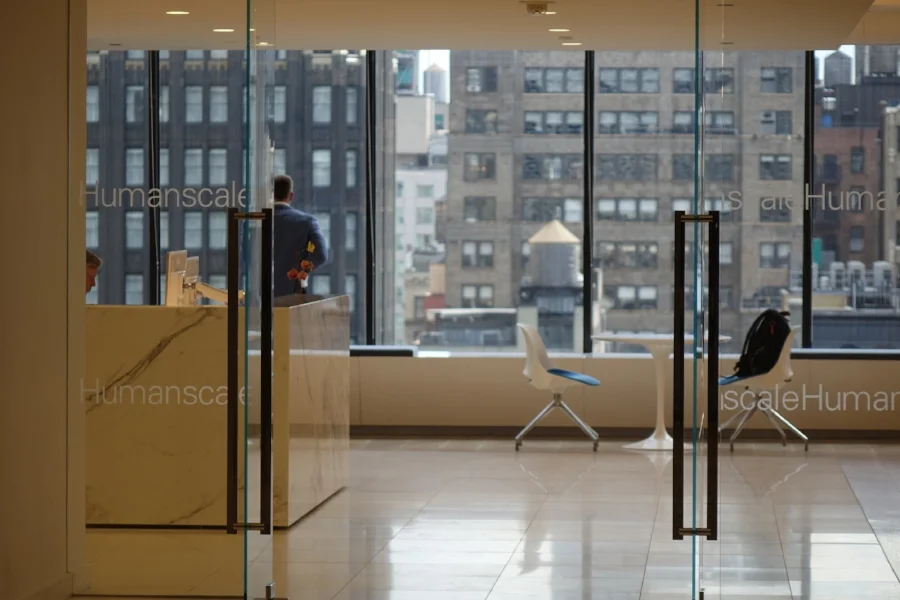When Humanscale decided to move its headquarters to the iconic W.R. Grace Building near Bryant Park in New York, a few things were non-negotiable: It had to be a space that was as environmentally friendly as the company itself, and it had to provide a neutral palette to show off its furniture.
Unlike its former headquarters on Washington Square Park, the new headquarters also was designed as a living showroom, a place where customers could come and see Humanscale products in action, said Leena Jain, chief marketing officer.
After a visit to the headquarters, it is clear Humanscale succeeded on most counts. Its showroom certainly is a neutral backdrop for its furniture with its stark white and gray canvas for products. The company uses white marbles and Mohawk carpet, the only carpet to achieve the Living Product Challenge.
The headquarters is purposely neutral, intended as a blank slate for its products. “It is clean and minimal and conscious of the environment,” Jain said.
The company and its 80 or so New York-based employees moved into the building on May 23 — just before NeoCon. Jain said they have tweaked the design since then and are finishing up some last minute items.
After living in the space for a few months, the company is going to add a few splashes of color to the front, plus art and company timelines.
The new headquarters is an important step for Humanscale, according to Jain. “It is a huge win for us to end up in the Grace Building,” she said.
The Grace Building was designed principally by Gordon Bunshaft, and completed in 1974. It is located at 1114 Sixth Avenue, but the main entrance is on 42nd Street, between Fifth and Sixth avenues. It overlooks Bryant Park and the New York Public Library's main branch. The building has approximately 1,518,000 rentable square feet, and Humanscale is on the 15th floor. The building is also home to Bain & Company, Cooley, Heidrick & Struggles, Interpublic Group of Companies, Kilpatrick Townsend & Stockton, Norddeutsche Landesbank, Partners Group and People's Bank of China, to name a few.
Founder and Chief Executive Officer Bob King said the former headquarters, which the company occupied through 20 years of incredible growth and change, was spread across three floors and wasn't convenient or efficient. “Now everyone is on the same floor, and that makes it much easier,” he said. “And there used to be some critics of the building, but it is a great space and fits our brand — simplicity and nature. It is also in the heart of New York.”
Humanscale was founded in 1983 by King and has certainly grown and changed. It hasn't wavered from its focus on high-performance tools that support a healthy, more active way of working. The company made its first mark as a workplace ergonomics pioneer in the 1990s with the introduction of articulating keyboard systems. Humanscale introduced the Freedom chair in 1999, created by renowned ergonomics designer Niels Diffrient. The innovative executive task chair broke new ground by combining functionality with minimal manual controls. Humanscale followed with a series of Diffrient seating designs including Liberty, Diffrient World and Smart chairs.
The office has floor-to-ceiling windows with beautiful views of the park, library and New York skyline, including the Empire State Building. The space was designed so everyone would have a view of the outside from anywhere in the office, Jain said.
In the old headquarters, the showroom was confined to the front of the building. Visitors rarely went beyond that space. The new headquarters is the showroom space with Humanscale seating and ergonomic products throughout. Interestingly, Humanscale went with Unifor desks instead of its Float sit-stand tables.
“Unifor makes the most beautiful desks in the world,” King said when asked why Float tables weren't used throughout. “And why would we use (Float tables) when not everyone wants to use (a sit-stand product).”
King said any employee can ask for one of the company's Quickstand products that turns a static desk — like the Unifor product — into a sit-stand desk.
The office itself is definitely more open than the old headquarters, which felt crowded and stuffy. “Now I can sit in my office and see customers come through all day long,” King said.
The office simply works better for the company, Jain said. Only a couple of conference rooms were in the former headquarters, while dozens fill the new space. Creating a new headquarters also gives Humanscale a real understanding of what its customers go through when doing the same.
The new space marks a new era for Humanscale, but holds true to what the company was founded on: clean, minimalistic design that is open and accessible.












